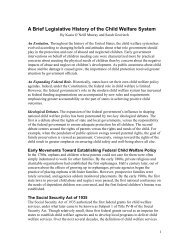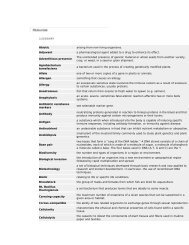Protecting Western Australia's Big Blue Backyard - The Pew ...
Protecting Western Australia's Big Blue Backyard - The Pew ...
Protecting Western Australia's Big Blue Backyard - The Pew ...
Create successful ePaper yourself
Turn your PDF publications into a flip-book with our unique Google optimized e-Paper software.
CURRENT AFFAIRS<br />
Ocean waters are never still. <strong>The</strong> rise and fall of<br />
waves, the ebb and flood of tides, the ups and<br />
downs of canyon waters, the spirals in eddies and<br />
the streaming of currents—ocean water is always<br />
on the move and marine life goes with the flow.<br />
In the world of ocean currents there is nothing<br />
quite like the Leeuwin Current. It is the only major<br />
current in the world that flows south along the<br />
eastern side of an ocean basin—all others<br />
flow north.<br />
By heading south, the Leeuwin Current has created<br />
a marine and coastal environment in <strong>Western</strong><br />
Australia that is very different to that provided by<br />
the cool and northerly currents off the west coasts<br />
of Africa and South America. <strong>The</strong> Leeuwin Current<br />
makes <strong>Western</strong> Australia’s marine environment a<br />
very special place in the world.<br />
Currents like the Leeuwin transport marine life<br />
around the oceans of the world. <strong>The</strong>y form in<br />
response to the effects of solar heating, wind,<br />
gravity and the Earth’s rotation, and are influenced<br />
by variations in atmospheric pressure, water<br />
temperature, salinity and sea floor shape.<br />
Coastal climates are affected by ocean<br />
currents—warm currents, such as the Leeuwin<br />
Current, lead to increased evaporation and higher<br />
rainfall along nearby coasts, while evaporation and<br />
rainfall are lower on coasts bordered by<br />
cold currents.<br />
Fisheries can be enhanced by ocean currents.<br />
Equator-bound, west-coast currents such as the<br />
Benguela off Africa and the Humboldt off South<br />
America bring upwellings of cool, nutrient-rich<br />
water to the surface. This drives marine plant<br />
production and attracts enormous amounts of<br />
surface-dwelling fish that are targeted by some<br />
of the world’s major fisheries. In contrast, with<br />
no major northerly flowing surface currents and<br />
nutrient-poor marine waters, Australia ranks fiftieth<br />
in world fisheries production even though we have<br />
the third-largest marine area in our care.<br />
<strong>The</strong>re are six main currents in the Kalbarri to<br />
Eucla region—the Leeuwin Current, the Leeuwin<br />
Undercurrent, the <strong>Western</strong> Australian Current, the<br />
Flinders Current and the seasonal and inshore<br />
Capes and Creswell currents. <strong>The</strong>y flow in different<br />
directions and with varying strengths, but each has<br />
its own special influence on the region’s marine<br />
environment and marine life. By far the most<br />
important of these is the Leeuwin Current.<br />
<strong>The</strong> Leeuwin Current is like the southbound lanes<br />
of a freeway and marine life is like the traffic.<br />
<strong>The</strong> lower deck is the Leeuwin Undercurrent, while<br />
breakaway eddies are the exits and on-ramps.<br />
During summer the northbound traffic of the<br />
Capes Current is driven by south-east winds off<br />
capes Leeuwin and Naturaliste. Once around<br />
Cape Leeuwin, the Leeuwin freeway is eastbound,<br />
while the cooler Flinders Current carries<br />
westbound traffic.<br />
TAKING THE TROPICS SOUTH<br />
<strong>The</strong> Leeuwin Current begins its long and important<br />
journey in the tropical waters surrounding the<br />
Indonesian islands. <strong>The</strong> warm waters around the<br />
islands are less dense and lower in salinity than the<br />
cooler waters of southern Australia. <strong>The</strong> result is a<br />
sea level around the islands that is 50 centimetres<br />
higher than in the south. In response, the Leeuwin<br />
Current does what water normally does—it flows<br />
‘downhill’.<br />
<strong>The</strong> strength of the Leeuwin Current in the Indian<br />
Ocean is variable from year to year and season to<br />
season—it is at its strongest in autumn and winter.<br />
<strong>The</strong> current’s variations in strength are related to<br />
major ocean processes in the Pacific Ocean, which<br />
are linked to the Indian Ocean through Torres<br />
Strait and the waters across northern Australia.<br />
During what are called El Niño events, differences<br />
in atmospheric pressure push sea level higher on<br />
the eastern side of the Pacific and reduce sea level<br />
around the Indonesian islands. At these times the<br />
sea level gradient along the west coast is reduced<br />
and the Leeuwin Current is weaker.<br />
With La Niña events, sea level is relatively higher<br />
on the western side of the Pacific and also around<br />
the Indonesian islands. When this occurs the<br />
sea level gradient is steeper and the Leeuwin<br />
Current stronger.<br />
From Indonesia the Leeuwin Current carries warm<br />
and clear tropical water down the west coast of<br />
<strong>Western</strong> Australia, around Cape Leeuwin, along<br />
the state’s south coast, across the Great Australian<br />
<strong>Big</strong>ht, finally ending on the western shores of<br />
Tasmania. At 5500 kilometres, it is the world’s<br />
longest continuous coastal current.<br />
Tropical fish larvae and coral polyps, whales,<br />
tuna and other marine life are either taken or<br />
go along for the ride. <strong>The</strong> world’s largest marine<br />
turtle, the endangered leatherback turtle, drifts<br />
with the current while surface-feeding on jellyfish.<br />
It can also swim away from the current and dive<br />
to depths of 1200 metres on the continental slope.<br />
As water temperatures rise with climate change,<br />
the Leeuwin Current could bring more tropical<br />
coral species into the region and carry them even<br />
further south. This is the conclusion of a scientific<br />
study of fossil evidence by the ARC Centre of<br />
Excellence for Coral Reef Studies. According to<br />
the analysis, tropical coral species could move<br />
south to avoid coral bleaching and coral diseases<br />
associated with warmer water in the tropics.<br />
<strong>The</strong>re are suitable areas of shallow and clear water<br />
off the west coast of <strong>Western</strong> Australia where<br />
these climate refugees could re-establish<br />
themselves as southern waters also warm with<br />
climate change. <strong>The</strong> Centre of Excellence<br />
believes these areas need to be protected and<br />
well managed to provide a sanctuary for these<br />
travelling coral species.<br />
CREATING A UNIQUE MARINE REGION<br />
As it rounds Shark Bay the Leeuwin Current enters<br />
the Kalbarri to Eucla region. About 200 kilometres<br />
to the west are the recently discovered wrecks<br />
of HMAS Sydney II and the German cruiser, the<br />
Kormoran, both sunk in battle with one another<br />
in 1941.<br />
On passing Kalbarri, the Leeuwin Current is less<br />
than 100 kilometres wide, barely 300 metres deep<br />
and travelling at about two kilometres per hour.<br />
From here its journey will have a profound effect<br />
on the region’s marine life, climate and people.<br />
<strong>The</strong> Leeuwin Current’s warm waters moderate<br />
winter temperatures and encourage higher annual<br />
rainfalls than would normally occur here. It brings<br />
tropical species south where they are shaken and<br />
stirred with subtropical and temperate species in<br />
a remarkable cocktail of marine life. <strong>Blue</strong> whales<br />
and southern right whales from cooler waters share<br />
the region’s ocean with tropical short-finned pilot<br />
whales, and striped and spinner dolphins.<br />
<strong>The</strong> Leeuwin Current’s influence, the region’s<br />
isolation and a history free of major environmental<br />
disturbance over geological time have created<br />
a marine environment unlike any other. Marine<br />
plants and animals have evolved here in their<br />
own ways, making the best of a unique west<br />
coast environment. Most of them are not found<br />
anywhere else in the world, making this region<br />
globally unique.<br />
<strong>The</strong> Current’s southerly movement prevents<br />
upwellings of nutrients from the sea floor.<br />
This suppresses blooms of phytoplankton (tiny<br />
plants) and zooplankton (tiny animals). In turn,<br />
this limits the abundance of surface-dwelling fish<br />
that target the plankton for food.<br />
With only a few small river discharges, nutrient<br />
levels are very low and the warm waters crystal<br />
clear. Seaweeds and seagrasses thrive in depths<br />
much greater than usual—extensive seagrass<br />
beds on the west coast are found in water at<br />
least 30 metres deep. <strong>The</strong>se are critical feeding<br />
and nursery areas for marine species targeted by<br />
commercial and recreational fishers.<br />
<strong>The</strong> low level of nutrients in surface waters and<br />
the water column also means that marine species<br />
living on or near the sea floor are more numerous<br />
and most are invertebrates, not fish. As a result,<br />
the region’s commercial fisheries largely target<br />
bottom-dwelling crustaceans and molluscs:<br />
western rock lobster, deep sea crabs, prawns,<br />
abalone and scallops.<br />
Upward and downward spirals of water break<br />
off the Leeuwin Current at the Abrolhos Islands,<br />
Jurien Bay, Rottnest Island and Cape Naturaliste<br />
and assist the region’s upwellings. <strong>The</strong>se eddies<br />
can also carry marine life off the continental shelf,<br />
out into the Indian Ocean and possibly back again,<br />
fuelling food supplies for open-ocean species.<br />
Where localised upwellings of nutrients do occur,<br />
usually at the heads of submerged canyons etched<br />
in the edge of the continental shelf, they become<br />
oases for larger marine life. Between these oases,<br />
marine animals and plants have adapted to an<br />
environment low in nutrients but with deep<br />
light penetration.<br />
<strong>The</strong> nutrients raised by the upwellings are a<br />
mixture of materials from marine animals and<br />
plants that have died and sunk to the seabed,<br />
and plants, nitrogen, phosphorous and silica<br />
flowing from rivers.<br />
Nutrients are just what phytoplankton and<br />
zooplankton need for growth, and small<br />
surface-dwelling fish such as pilchards, herring,<br />
sprat, anchovies, red bait and jack mackerel gather<br />
in vast numbers to feast on them. In turn they<br />
are eaten by southern bluefin tuna and spanish<br />
mackerel. <strong>The</strong>se large and mobile predators<br />
survive on limited food resources while travelling<br />
between upwellings.<br />
<strong>The</strong>re is still much scientists do not know about<br />
the Leeuwin Current or the impact climate change<br />
might have on its nature and strength.<br />
However, there is no doubt that the Leeuwin<br />
Current has brought together a unique and<br />
internationally significant mix of marine life<br />
in <strong>Western</strong> Australia’s big blue backyard.<br />
14<br />
<strong>The</strong> Leeuwin Current<br />
makes <strong>Western</strong> Australia’s<br />
marine environment a very<br />
special place in the world<br />
15
















